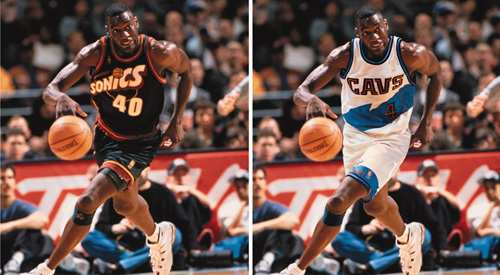
Shawn Kemp: The Cleveland Years
The narrative of Shawn Kemp’s life is familiar. The name alone instantly yields memories of substance abuse, grabbed crotches, punch lines of illegitimate children and the 1996 NBA Finals.
One chapter that often gets lost among the confusion of the overwhelming tale, however, revolves around a three-year stint in which the dominating forward uncharacteristically donned the uniform of a late-90s Cleveland Cavaliers team following an alleged fallout over contract terms with his former Supersonics.
Despite the high hopes of stakeholders, Kemp’s Ohio tenure was forgettable to say the least, after starting in 1997 when a three-team trade bumped Cavalier favorites Terrell Brandon and teammate Tyrone Hilll to Milwaukee.
In the same deal – one that in hindsight resembles an NBA-wide game of dysfunctional potato – then-Buck Vin Baker replaced Kemp in Seattle.
From tip off of the 1997-98 season until the buzzer sounded on their 2000 campaign, Kemp and the Cavs labored to a pedestrian 101-113 record. Life was as one would expect it to be in a city on the verge of a Lamond Murray Era, not particularly fulfilling but at least the Browns were back.
On the hardwood, the underwhelming roster qualified for the playoffs. Wesley Person and a 22-year-old Zydrunas Ilgauskas battled valiantly alongside Kemp in his first year with the club before falling to the eventual Eastern Conference Champion Pacers.
[php snippet=1]
Though they factored into playoff discussion in each of the next two seasons, no one denied the fact that the future was bleak. Bleak, of course, being an understatement for a three-year-long nightmare haplessly navigated by Andre Miller, Ricky Davis and Chris Mihm.
For Kemp, the three years in Cleveland from 1997-2000 were a fitting contrast to his former life. Though it was with the Cavaliers where he signed the mammoth contract he so adamantly desired, the city lacked flare and the franchise lacked Gary Payton. In the years that sandwiched the 1998 NBA lockout, the entire Cleveland experience lacked the visibility, global fanfare and overall relevance of what Kemp, nay, “the Reign Man” was used to.
Though the increasingly rotund power forward functioned admirably in the Cleveland cyan of yesteryear, his conditioning faltered and the direction of the franchise quickly changed.
In 80 games with his new team after signing the first truly substantial contract of his career, Kemp averaged 18.0 points and 9.3 rebounds per game. The following year, despite a ballooning weight problem, Kemp upped his production to 20.5 points and 9.2 boards.
The numbers, of course, are only that, arguably-useless figures easily manipulated by possessions and opportunity, but they remain significant to the overarching story nonetheless.
Though hindsight reveals that the Legend of Shawn Kemp effectively died the day Jim McIlvane’s contract drew Kemp’s ire (serving essentially as the Franz Ferdinand assassination of the Sonics dynasty), the statistics show that Kemp, and his career, forged ahead like Wile E. Coyote off a cliff before realizing he should rather be falling.
An All-Star in 1998 and similarly productive in the years that followed, it’s hard to call Kemp’s Ohio stopover the beginning of the end of his career, but it was, in fact, here where the ugly climax of his story began to take form and this is what history remembers.
As Kemp’s well-documented personal issues started to pile up, the work stoppage that was the lockout only made matters worse. Without the presence of training camps, exhibition play and the start of the regular season to keep him on his feet Kemp gained significant weight, issuing the end of the lean, 230-pound wrecking ball he lives on as today only in sun-bleached posters of the late 20th century.
By the end of the 1999-2000 campaign, with their fate more decided than ever, the Cavs publicly veered away from their ambitious attempt to build a winner in Cleveland through the acquisition of a legitimate superstar and shipped the then-275-pound Kemp to the Portland Trailblazers.
In Portland (and subsequently Orlando), despite hanging 23 points and 13 rebounds on the New Jersey Nets in his last game as a Cav in April of 2000, Kemp would never average more than 7.0 points per game again. It was an abruptly violent decline comparable only to the steep realization that the Roadrunner had proved elusive before plummeting to the rock-bottom of a cliff-side valley.
For years after his 2002 retirement Kemp struggled to cope with the squandering of his career, pursuing a return to the game with a number of different teams from Denver to Rome. Unfortunately, in addition to a skill set that doesn’t lend itself well to old age, Kemp’s off-the-court battle with cocaine and alcohol addiction only accelerated the process.
With necessary rehabilitation already standing in his way, Kemp’s pursuit of a return to the game was further hindered by everything from ailing relatives to legal problems to 2008’s Hurricane Ike.
With the conclusive, and inarguably more depressing chapters of Kemp’s saga now in the books, all that remains are memories of the man that helped guide one of the NBA’s most fascinating rosters to the 1996 NBA Finals and the train wreck that ended it all.
Forgotten in the interim remain some of the most telling events of the man’s disappointing story arc, most notably his desperate attempt to trick fate and avoid a predictably tragic ending.
[php snippet=1]

